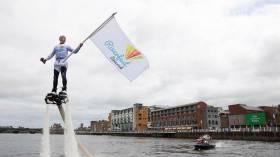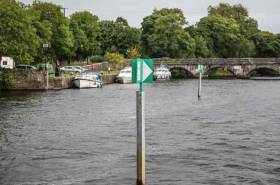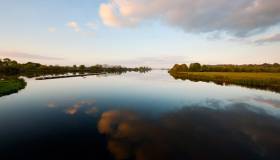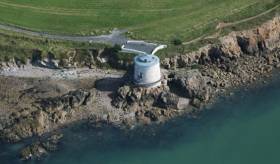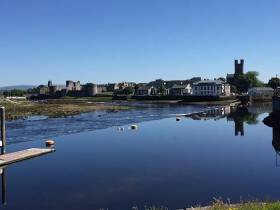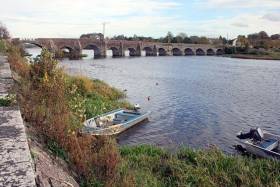Displaying items by tag: River Shannon
Limerick Riverfest Kicks Off Today For May Bank Holiday Weekend
#Festivals - Limerick becomes a mecca for watersport enthusiasts this May Bank Holiday weekend for the city’s Riverfest 2017, which kicks off today (Friday 28 April).
Highlights of the city’s premier summer maritime festival include the Riverfest BBQ Competition, the Riverfestival village in Arthur’s Quay Park, the Barringtons Hospital Great Limerick Run, a spectacular fireworks display.
At the centre of it all is the Maldron Hotel Riverfest on the Shannon, featuring wakeboarding with Irish champion David O Caoimh and pro jetboarders Scotty Knemeyer and Bo Krook, as well as the River Shannon Zipline between Arthur’s Quay and Honan’s Quay for more thrill-seeking visitors.
Exciting and skilful displays by Limerick Marine Search and Rescue, the Defence Forces, Foynes Yacht Club, Limerick’s numerous rowing clubs and yachting and sailability groups will mean all eyes will be firmly focused on the water.
For full details of the festival lineup visit the official website HERE.
And don’t forget the Dublin Port Riverfest that returns for the June Bank Holiday, as previously reported on Afloat.ie.
#Shannon - Minister of State for Flood Relief Seán Canney outlined a range of additional measures being taken to address flood risk on the River Shannon at the recent Environ 2017 conference in Athlone.
Speaking at the event in AIT last Monday (10 April), Minister Canney made reference to the most recent meeting of the Shannon Flood Risk State Agency Co-ordination Working Group on 21 March, which set out its actions manage flood risk for the Shannon catchment.
“This extensive work programme demonstrates the ongoing work and co-ordination by all State bodies to jointly and proactively address flood risk on the Shannon,” he said.
The work programme follows from the major decision taken last December to develop a plan for a strategic maintenance programme on the River Shannon, as previously reported on Afloat.ie.
The working group established a sub-committee to develop the plan that will halt the deterioration of the river channel and complement the preferred measures for those areas at assessed risk identified through the Shannon CFRAM Study.
Minister Canney announced that the working group has now agreed to the delivery of targeted maintenance in specific locations that are being identified as feasible by the sub-committee.
“The recent targeted activity by Waterways Ireland and the OPW around Madden’s Island downstream of Athlone is a successful demonstration of this collaborative approach,” he said, “and both the Group and I would like to acknowledge the valuable contribution of the NPWS to ensure that the clearing of the trees was carried out appropriately to enhance the conveyance capacity of the channel.”
The minister added that the working group has agreed to some environmental and habitat surveys as a first necessary step to inform a long-term plan of maintenance. The group will also identify any policy or legislative barriers to progressing maintenance works that can benefit flood risk management.
Additionally, the working group has agreed to review and continue the pilot lowering of the levels on Lough Allen during the winter season for another year.
Minister Canney said the protocols agreed between the ESB, Waterways Ireland and the Office of Public Works (OPW) were successfully implemented resulting in a lowering of the target winter water level by 0.7 metres.
However, working group acknowledged that the impact of the trial on flooding has not been fully tested due to the relatively dry winter period up until late February this year.
Regarding the impact of summer flooding on the agricultural community, the minister said the working group has endorsed a specific project to identify viable flood risk reduction measures in the Shannon Callows.
Building on initial assessments undertaken as part of the Shannon CFRAM study, the OPW is leading on the project in conjunction with Waterways Ireland, Inland Fisheries Ireland and the National Parks and Wildlife Service (NPWS). This project will include more detailed assessment of the possible removal of identified constrictions or ‘pinch points’ upstream of Meelick Weir.
“I am delighted that the group, which is chaired by the OPW, is progressing the plans for strategic maintenance works on the River Shannon,” said Minister Canney. “This will complement the group’s work programme and the specific measures that are identified for the areas at significant risk in the Draft Shannon Flood Risk Management Plan.
“I welcome the twin-track approach being adopted which will see targeted maintenance activity being carried out while a proposal for a long-term strategic programme is being developed.”
The minister added: "The activities of the group play a valuable role in supporting the objectives of the Action Plan for Rural Development, ‘Realising our Rural Potential’. In particular, the progression of flood relief actions in the Shannon catchment identified in the action plan along with those identified for the country as a whole, will have a positive impact on rural communities who are living with flood risk.”
Bodies Of Couple Recovered From Carrick-on-Shannon Marina
#Shannon - RTÉ News reports that the bodies of a man and a woman were recovered from the water at a marina in Carrick-on-Shannon yesterday afternoon (Friday 31 March) just hours after they were reported missing.
The couple, an Irish man and an English woman living in Germany, had been boating in the area since the beginning of the week, and were last seen at a restaurant near the Co Leitrim town’s marina on Wednesday night (29 March). The deaths are being treated as accidental.
Water Abstraction Will Affect Entire Shannon Navigation – IWAI
The Inland Waterways Association of Ireland (IWAI) has responded to Irish Water’s third Public Consultation on the Preferred Option to abstract water from Parteen Basin to service the East and Midlands region.
In its submission IWAI has again expressed grave concerns over the impact that this abstraction will have, not just on Lough Derg, but on the entire Shannon Navigation.
In an effort to mitigate this risk, IWAI puts forward the view that water levels should be monitored and controlled by a single authority, that weirs on the River Shannon should be automated and that flow levels at weirs should be collated and presented by way of a public web portal.
The full IWAI submission, compiled by Association Past Presidents Gregory Whelan and Carmel Meegan, is attached below.
Man Recovered From Shannon After Leaving Taxi On Limerick City Bridge
#Rescue - Swift water rescuers from the Limerick Fire Service raced to the aid of a man from the River Shannon in the city centre last night (Friday 10 February).
As BreakingNews.ie reports, the casualty had entered the water at Shannon Bridge after leaving a taxi on the bridge around 10pm.
Passers-by threw the man a life buoy which kept him afloat till the rescue boat arrived just minutes later, recovering him to the slipway at St Michael's Rowing Club for treatment before transfer to hospital.
Strategic Maintenance Plan Decided For Shannon Flood Risk Management
#Shannon - The latest meeting of the Shannon Flood Risk State Agency Co-ordination Working Group in Carrick-on-Shannon saw the unprecedented decision to develop a plan for a strategic maintenance programme on the River Shannon.
Programmed maintenance works have not been carried out on the Shannon for a significant period of time, and silt and vegetation have built up, which impacts on the river’s conveyance capacity.
The Shannon Flood Risk Group, which is led by the Office of Public Works (OPW), considers that maintenance works on the Shannon are essential to halt the deterioration of the river channel.
The group recognises that the carrying out such maintenance will be problematic and in bringing forward its plans, it will be addressing all of the necessary legal, environmental, technical and other considerations that arise, and will bring together all of the relevant stakeholders to discuss, initiate and manage the development of this programme.
Séan Canney, Minister of State for the OPW and Flood Relief, was in attendance at the meeting on Friday 2 December.
“The OPW already maintains over 11,500 km of river channel and over 700km of embankments protecting some 650,000 acres of agricultural land,” he said. “I am delighted that the group, which is chaired by the OPW, has taken the decision to develop a plan for strategic maintenance works on the River Shannon.
“There have been many calls for a maintenance programme to be put in place for the Shannon. A planned maintenance programme for the Shannon would complement the group’s work programme and the specific measures that are identified for the areas at risk in the Draft Shannon Flood Risk Management Plan.
Minister Canney said such plans “are a major step forward to help Government make informed investment decisions on flood risk management and for which the Government has provided €430 million in the Capital Investment Plan 2016 to 2021.
“This is very positive news and comes on top of the decisions by the group at its last meeting to trial the lowering of the lake levels in Lough Allen to help mitigate potential flood risk for this winter ,and to evaluate the benefits from any short- and medium-term programme of localised dredging and any future piloting to remove some pinch points along the Shannon.”
The Shannon Flood Risk Group met for the first time in February of this year, as previously reported on Afloat.ie.
“The decisions taken by the group to date clearly demonstrate that it is working well and is firmly focussed on finding practical solutions that will help reduce flood risk on the Shannon to the benefit of the communities along our largest river,” said Minister Canney.
“The results of this cutting-edge project will inform consideration of rolling out a similar management model for other river basins.”
#Rescue - Twelve kayakers rescued amid difficult weather conditions in Dublin Bay yesterday had only limited safety equipment and had not logged their trip with the coastguard, as The Irish Times reports.
The kayaking group were recovered by the Howth Coast Guard and lifeguards from nearby Dollymount after high winds and an outgoing tide started pushing them out into the bay off Red Rock in Sutton yesterday evening (Sunday 7 August).
It since emerged that the 12 paddlers had failed to observe the small craft warning issued ahead of yesterday's forecast high winds, on top of setting out without a marine VHF radio and failing to log their journey with the National Maritime Operations Centre.
Elsewhere, four people were rescued after a fire broke out on their cruiser on the River Shannon near Banagher in Co Offaly at the weekend.
According to The Irish Times, the four on board the White Lady raised the alarm on Saturday evening (6 August) after the fire started in the boat's engine system.
The skipper was able to motor the boat to Banagher Harbour where waiting fire service units brought the blaze under control.
Limerick's newly appointed Minister of State Patrick O'Donovan has been asked to intervene with Waterways Ireland to reopen navigation of the River Shannon at Limerick city and avoid the loss of marine tourism revenue to the city writes Andrew Carey.
As Afloat.ie reported earlier, on April 25, Waterways Ireland issued a marine notice advising all users that the river from Limerick city to Parteen Weir would close to navigation.
It cited the "continuing high flow rates and infrastructural deficiencies as a result of the winter storms and subsequent flooding" as reasons for the closure.
Waterways Ireland said that the "floating breakwater at the entrance to the Abbey River in Limerick is no longer in place to protect vessels from striking the fixed weir. Also, there are many strong currents and eddies making navigation dangerous for both large and small craft.
A safety inspection of other damaged floating pontoons further upstream was to be carried out "when water levels and flows permit. Meanwhile, users are advised to stay clear of these until a further Marine Notice is issued on this matter."
Remedial works have yet to take place and the waterway remains closed to all marine traffic during the peak summer season.
Sailors from local sailing clubs wishing to access the Shannon now face the prospect of missing completions and events around the west coast and beyond as they can not pass through the navigation.
Last year, a six point plan to boost marine tourism on the Shannon and in Limerick was launched by then Education Minister Jan O'Sullivan.
The plans, drafted by Limerick marine enthusiasts to benefit local tourism, heritage and education, were submitted to Waterways Ireland.
Well-known boatman Pat Lysaght said that "Limerick is effectively landlocked and until these issues are rectified we will continue to lose out".
Calling for immediate intervention by Minister O'Donovan, who has responsibility for tourism and sport, Cllr Emmett O'Brien said the closure of the waterway "means no boats can sail from Limerick city to Killaloe. This may have a serious impact on local tourism and is contrary to all lip service being paid to Limerick being a riverside city.
"We need a clear and accurate response from Waterways Ireland and the Council why this has occurred and our local Minister for State for Tourism must intervene to ensure this navigation route does not remain closed."
Fianna Fáil Deputy Niall Collins said that it was of huge concern that "Limerick City is effectively closed off to marine tourism and this is having a detrimental impact on tourism across the Shannon region.
“I’m calling on Waterways Ireland to outline when the navigational hazards it has identified along the river will be addressed. We need to know the planned schedule of works and when the river will be reopened to marine traffic.
"We can’t have a situation whereby boats cannot sail up or down the River Shannon during the peak of the tourist season. This needs to be addressed without delay."
At the time of going to press, Limerick City Council and Minister O'Donovan had failed to respond to queries.
Waterways Ireland issued this statement on Wednesday afternoon.
"The stretch of navigation from Limerick city to Parteen Weir remains closed to navigation due to continuing infrastructural deficiencies as a result of the winter storms and subsequent flooding.
"Waterways Ireland, following the 2015/2016 flooding event has and continues to restore the infrastructure right along the Shannon navigation following on from the damage caused by record flood levels and the prolonged duration of these floods during last winter.
"However, Waterways Ireland has limited resources available to it and has had to prioritise its' interventions in those areas of greatest need and use."
The statement did not indicate any timeframe for reopening of the navigation.
Shannon Flood Risk Working Group Holding Open Day
#Shannon - The Shannon Flood Risk State Agency Co-ordination Working Group is holding its first open day on its published Work Programme for 2016 at the Civic Centre in Athlone from 11am to 3pm on Thursday 5 May.
Members of the public and other interested parties are invited to attend what will be one of a series of open days on the Working Group's programme this summer.
Subsequent open days will be held at other locations within the flooding-prone Shannon Catchment at later dates to be announced.
Limerick Man Convicted Of Illegal Fishing On River Shannon
#Angling - At a sitting of Killaloe District Court on Tuesday 5 April, Judge Patrick Durkan convicted a man of illegal fishing on the River Shannon at O’Brien’s Bridge in August 2015.
Joe Ahern of O’Brien’s Bridge, Co Limerick was found guilty of illegally fishing with prawns and was fined €750 and costs amounting to €1025. Ahern pleaded guilty to the offence and co-operated fully with the fishery officers.
Salmon angling on the River Shannon is currently permitted below O’Brien’s Bridge to Thomond Bridge in Limerick City under a local catch and release byelaw. Wild salmon must be returned immediately if caught and the use of prawns is prohibited under byelaw in the entire Shannon catchment.
These measures are present to protect returning wild salmon stocks, especially to large river catchments such as the River Shannon. The wild salmon populations in the Shannon River have declined in recent years.
In summarising his judgement on the case, Judge Patrick Durkan commented that fisheries were the greatest resource of this country and that fishery officers must be allowed to protect them.
Amanda Mooney, sirector at Inland Fisheries Ireland (IFI) in Limerick, said: “Anglers must adhere to conservation methods in place on our rivers as these measures are introduced to protect vulnerable stocks and provide an opportunity for rivers to recover.
"We need to work together to improve our stocks so that the wonderful resource can be passed onto the next generation. Inland Fisheries Ireland is committed to the protection of our wild salmon stocks.”
IFI has a confidential hotline number to enable members of the general public to report incidents - 1890 34 74 24 or 1890 FISH 24. This phone line is designed to encourage the reporting of incidents of illegal fishing, water pollution and invasive species.


























